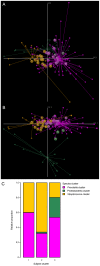Composition of microbial oral biofilms during maturation in young healthy adults
- PMID: 24503584
- PMCID: PMC3913613
- DOI: 10.1371/journal.pone.0087449
Composition of microbial oral biofilms during maturation in young healthy adults
Abstract
In the present study we aimed to analyze the bacterial community structure of oral biofilms at different maturation stages in young healthy adults. Oral biofilms established on membrane filters were collected from 32 human subjects after 5 different maturation intervals (1, 3, 5, 9 and 14 days) and the respective phylogenetic diversity was analyzed by 16S rDNA amplicon sequencing. Our analyses revealed highly diverse entire colonization profiles, spread into 8 phyla/candidate divisions and in 15 different bacterial classes. A large inter-individual difference in the subjects' microbiota was observed, comprising 35% of the total variance, but lacking conspicuous general temporal trends in both alpha and beta diversity. We further obtained strong evidence that subjects can be categorized into three clusters based on three differently occurring and mutually exclusive species clusters.
Conflict of interest statement
Figures


Similar articles
-
Health- and disease-associated species clusters in complex natural biofilms determine the innate immune response in oral epithelial cells during biofilm maturation.FEMS Microbiol Lett. 2014 Nov;360(2):137-43. doi: 10.1111/1574-6968.12596. Epub 2014 Sep 29. FEMS Microbiol Lett. 2014. PMID: 25212593
-
Determinants and Interactions of Oral Bacterial and Fungal Microbiota in Healthy Chinese Adults.Microbiol Spectr. 2022 Feb 23;10(1):e0241021. doi: 10.1128/spectrum.02410-21. Epub 2022 Feb 2. Microbiol Spectr. 2022. PMID: 35107355 Free PMC article.
-
High-resolution ISR amplicon sequencing reveals personalized oral microbiome.Microbiome. 2018 Sep 5;6(1):153. doi: 10.1186/s40168-018-0535-z. Microbiome. 2018. PMID: 30185233 Free PMC article.
-
Polymicrobial Candida biofilms: friends and foe in the oral cavity.FEMS Yeast Res. 2015 Nov;15(7):fov077. doi: 10.1093/femsyr/fov077. Epub 2015 Aug 21. FEMS Yeast Res. 2015. PMID: 26298018 Review.
-
The Oral Microbiota.Adv Exp Med Biol. 2016;902:45-60. doi: 10.1007/978-3-319-31248-4_4. Adv Exp Med Biol. 2016. PMID: 27161350 Review.
Cited by
-
Composition of Bacterial Communities Associated with Aurelia aurita Changes with Compartment, Life Stage, and Population.Appl Environ Microbiol. 2015 Sep 1;81(17):6038-52. doi: 10.1128/AEM.01601-15. Epub 2015 Jun 26. Appl Environ Microbiol. 2015. PMID: 26116680 Free PMC article.
-
Restructuring of Epibacterial Communities on Fucus vesiculosus forma mytili in Response to Elevated pCO2 and Increased Temperature Levels.Front Microbiol. 2016 Mar 31;7:434. doi: 10.3389/fmicb.2016.00434. eCollection 2016. Front Microbiol. 2016. PMID: 27065988 Free PMC article.
-
Dental plaque development on a hydroxyapatite disk in young adults observed by using a barcoded pyrosequencing approach.Sci Rep. 2015 Jan 30;5:8136. doi: 10.1038/srep08136. Sci Rep. 2015. PMID: 25633431 Free PMC article.
-
Fungal, Bacterial, and Archaeal Diversity in Soils Beneath Native and Introduced Plants in Fiji, South Pacific.Microb Ecol. 2019 Jul;78(1):136-146. doi: 10.1007/s00248-018-1266-1. Epub 2018 Oct 4. Microb Ecol. 2019. PMID: 30288545
-
In situ substrate-formed biofilms using IDODS mimic supragingival tooth-formed biofilms.J Oral Microbiol. 2018 Aug 1;10(1):1495975. doi: 10.1080/20002297.2018.1495975. eCollection 2018. J Oral Microbiol. 2018. PMID: 30181819 Free PMC article.
References
-
- Parahitiyawa NB, Scully C, Leung WK, Yam WC, Jin LJ, et al. (2010) Exploring the oral bacterial flora: current status and future directions. Oral Diseases 16: 136–145. - PubMed
Publication types
MeSH terms
LinkOut - more resources
Full Text Sources
Other Literature Sources

